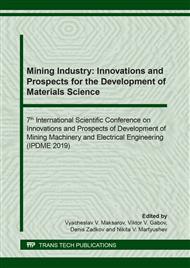[1]
N.N. Onoprienko, Sh.М. Rahimbaev, Influence of composition of functional additives and deformation modes on flow behavior of polymer composite materials, IOP Conf. Ser.: Mater. Sci. Eng. 327 (2018) 032043.
DOI: 10.1088/1757-899x/327/3/032043
Google Scholar
[2]
O.V. Lebedeva et al., Development of composite membrane materials for fuel cells IOP Conf. Ser.: Mater. Sci. Eng. 327 (2018) 032016.
DOI: 10.1088/1757-899x/327/3/032016
Google Scholar
[3]
Ch. Red, The Outlook for Thermoplastics in Aerospace Composites, 2014–2023 (2014).
Google Scholar
[4]
M.L. Kerber, V.M. Vinogradov, G.S. Golovkin et al., Polymer composite materials: structure, properties, technology, Profession,, St. Petersburg, 2011, 560 p.
Google Scholar
[5]
K. Chawla Krishan, Composite Materials Science and Engineering 3rd ed., Springer, New York; Springer, Heidelberg Dordrecht London, 2013, 542 p.
Google Scholar
[6]
P.K. Mallick, Fiber Reinforced Composites Materials, Manu-facturing, and Design 3rd ed., CRC Press Taylor & Francis Group, New York, 2007, 616 p.
Google Scholar
[7]
F.C. Campbell, Structural Composite Materials Materials Park, ASM International®, Ohio 44073-0002, 2010, 629 p.
Google Scholar
[8]
George Wypych, Handbook of Polymers 2rd ed., ChemTec Publishing, Toronto, 2016, 711 p.
Google Scholar
[9]
A. McIlhagger, E. Archer, R. McIlhagger, Manufacturing processes for composite materials and components for aerospace applications Woodhead Publishing Series in Composites Science and Engineering: Number 50 Polymer Composites in the Aerospace Industry, Woodhead Publishing, Cambridge, 2015, p.53–75.
DOI: 10.1016/b978-0-85709-523-7.00003-7
Google Scholar
[10]
A.M. Yuvshin, Y.S. Andreev, A.S. Vosorkin, Y.I. Yablochnikov, Robotized Complex for the Realization of Technology of Automated Placing of Products from Thermoplastic Composite Materials, J. of Instrum. Engineer. 61 672–677.
DOI: 10.17586/0021-3454-2018-61-8-672-677
Google Scholar
[11]
W. McKeen Laurence, The Effect of UV Light and Weather on Plastic and Elastomer, third ed., Elsevier, Waltham, 2013, 388 p.
Google Scholar
[12]
D. Maurer, P. Mitschang, Laser-powered tape placement process – simulation and optimization Advanced Manufacturing: Polymer & Composites, Sci. 2015, 129–137.
DOI: 10.1080/20550340.2015.1114798
Google Scholar
[13]
W. Grouve, Weld Strenght of Laser-Assisted Tape placement Thermoplastic Composites, Ipskamp Drukkers, Netherlands, 2012, 152 p.
Google Scholar
[14]
F.O. Sonmez, Mustafa Akbulut, Process optimization of tape placement for thermoplastic composites, Composites, Part A 38 (2007) 2013–(2023).
DOI: 10.1016/j.compositesa.2007.05.003
Google Scholar
[15]
F.O. Sonmez, H. Thomas Hahn, Analysis of the On-Line Consolidation Process in Thermoplastic Composite Tape Placement, J. of Thermoplastic Composite Mater. 10 (1997) 543–572.
DOI: 10.1177/089270579701000604
Google Scholar


